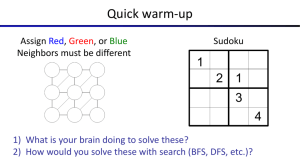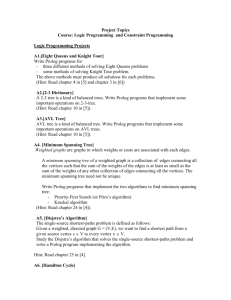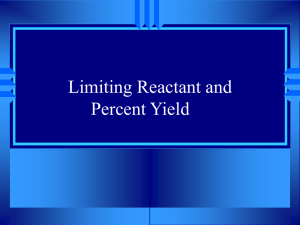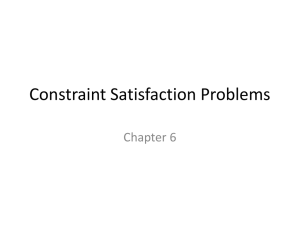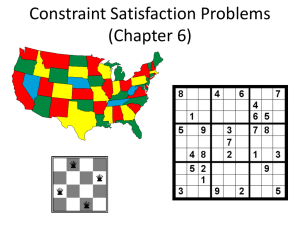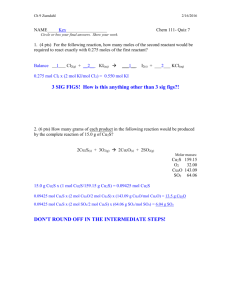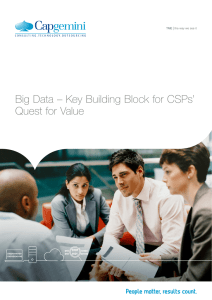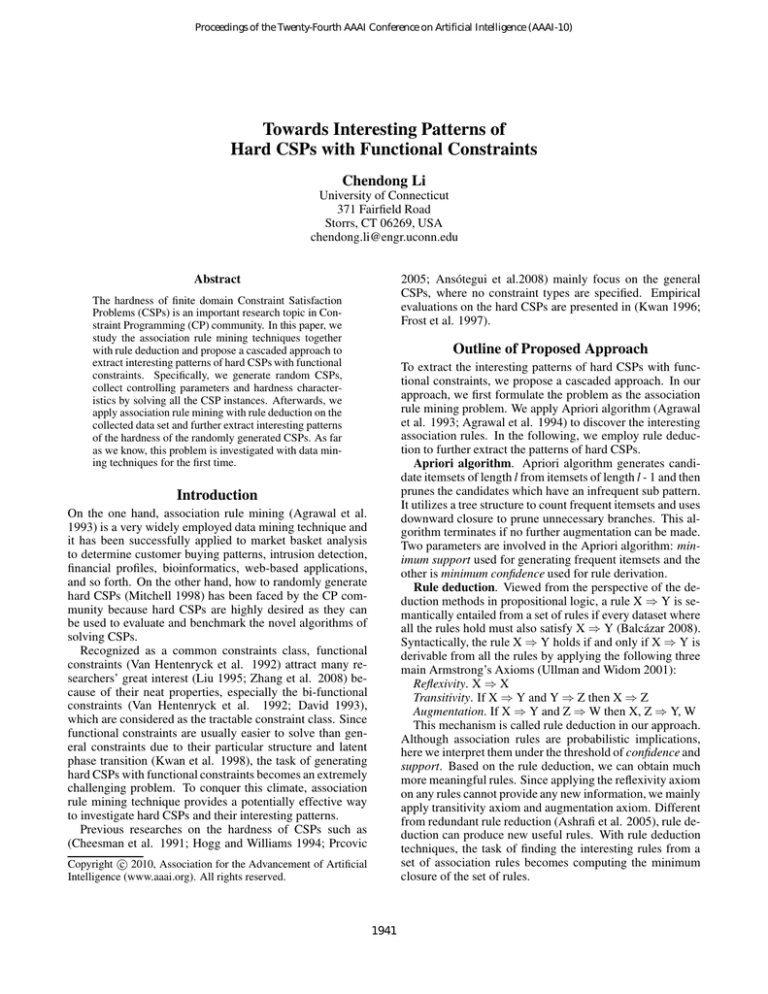
Proceedings of the Twenty-Fourth AAAI Conference on Artificial Intelligence (AAAI-10)
Towards Interesting Patterns of
Hard CSPs with Functional Constraints
Chendong Li
University of Connecticut
371 Fairfield Road
Storrs, CT 06269, USA
chendong.li@engr.uconn.edu
Abstract
2005; Ansótegui et al.2008) mainly focus on the general
CSPs, where no constraint types are specified. Empirical
evaluations on the hard CSPs are presented in (Kwan 1996;
Frost et al. 1997).
The hardness of finite domain Constraint Satisfaction
Problems (CSPs) is an important research topic in Constraint Programming (CP) community. In this paper, we
study the association rule mining techniques together
with rule deduction and propose a cascaded approach to
extract interesting patterns of hard CSPs with functional
constraints. Specifically, we generate random CSPs,
collect controlling parameters and hardness characteristics by solving all the CSP instances. Afterwards, we
apply association rule mining with rule deduction on the
collected data set and further extract interesting patterns
of the hardness of the randomly generated CSPs. As far
as we know, this problem is investigated with data mining techniques for the first time.
Outline of Proposed Approach
To extract the interesting patterns of hard CSPs with functional constraints, we propose a cascaded approach. In our
approach, we first formulate the problem as the association
rule mining problem. We apply Apriori algorithm (Agrawal
et al. 1993; Agrawal et al. 1994) to discover the interesting
association rules. In the following, we employ rule deduction to further extract the patterns of hard CSPs.
Apriori algorithm. Apriori algorithm generates candidate itemsets of length l from itemsets of length l - 1 and then
prunes the candidates which have an infrequent sub pattern.
It utilizes a tree structure to count frequent itemsets and uses
downward closure to prune unnecessary branches. This algorithm terminates if no further augmentation can be made.
Two parameters are involved in the Apriori algorithm: minimum support used for generating frequent itemsets and the
other is minimum confidence used for rule derivation.
Rule deduction. Viewed from the perspective of the deduction methods in propositional logic, a rule X ⇒ Y is semantically entailed from a set of rules if every dataset where
all the rules hold must also satisfy X ⇒ Y (Balcázar 2008).
Syntactically, the rule X ⇒ Y holds if and only if X ⇒ Y is
derivable from all the rules by applying the following three
main Armstrong’s Axioms (Ullman and Widom 2001):
Reflexivity. X ⇒ X
Transitivity. If X ⇒ Y and Y ⇒ Z then X ⇒ Z
Augmentation. If X ⇒ Y and Z ⇒ W then X, Z ⇒ Y, W
This mechanism is called rule deduction in our approach.
Although association rules are probabilistic implications,
here we interpret them under the threshold of confidence and
support. Based on the rule deduction, we can obtain much
more meaningful rules. Since applying the reflexivity axiom
on any rules cannot provide any new information, we mainly
apply transitivity axiom and augmentation axiom. Different
from redundant rule reduction (Ashrafi et al. 2005), rule deduction can produce new useful rules. With rule deduction
techniques, the task of finding the interesting rules from a
set of association rules becomes computing the minimum
closure of the set of rules.
Introduction
On the one hand, association rule mining (Agrawal et al.
1993) is a very widely employed data mining technique and
it has been successfully applied to market basket analysis
to determine customer buying patterns, intrusion detection,
financial profiles, bioinformatics, web-based applications,
and so forth. On the other hand, how to randomly generate
hard CSPs (Mitchell 1998) has been faced by the CP community because hard CSPs are highly desired as they can
be used to evaluate and benchmark the novel algorithms of
solving CSPs.
Recognized as a common constraints class, functional
constraints (Van Hentenryck et al. 1992) attract many researchers’ great interest (Liu 1995; Zhang et al. 2008) because of their neat properties, especially the bi-functional
constraints (Van Hentenryck et al. 1992; David 1993),
which are considered as the tractable constraint class. Since
functional constraints are usually easier to solve than general constraints due to their particular structure and latent
phase transition (Kwan et al. 1998), the task of generating
hard CSPs with functional constraints becomes an extremely
challenging problem. To conquer this climate, association
rule mining technique provides a potentially effective way
to investigate hard CSPs and their interesting patterns.
Previous researches on the hardness of CSPs such as
(Cheesman et al. 1991; Hogg and Williams 1994; Prcovic
c 2010, Association for the Advancement of Artificial
Copyright Intelligence (www.aaai.org). All rights reserved.
1941
Experimental Results
By applying rule deduction to all the rules, we eventually
obtain the interesting patterns of hard CSPs. The patterns
reveal that tightness ∈ (0.6075, 0.628], constraints ∈ (691.7710] and functional constraints ∈ (27.95-30.4](if any), can
generate hard CSP instances. These CSP hardness patterns
can provide a very useful recommendation for generating
hard CSPs. Based on the patterns, one simply set n = 50,
d = 50, e = 700, tightness = 0.618, functional constraints =
29 (if any), the hard CSPs (with functional constraints) can
be generated. Also slight change on the tightness can yield
more interesting CSP instances.
In the experiments, we first generate CSP instances randomly based on the combinations of the controlling parameters, which are number of variables n, domain size of each
variable d, number of constraints e, number of functional
constraints nf, tightness of constraints t and seeds seed. To
generate all possible combinations, we employ additional 4
parameters (Specifically, step size of constraints stpc, step
size of functional constraints stpfc, step size of tightness stpt
and step size of seeds stps) to control the size of increasing
strides of the corresponding controlling parameters in the
batch files.
Given the huge exponential combinations of parameters,
even though we have fixed n and d to 50, we use 2-stepscanning strategy to deal with the huge combinations: 1)
scan sparsely to obtain typical distributions of hard CSPs; 2)
concentrate on the relatively small distribution space established at step 1). In the experiment, based on computational
results of scanning at step 1), we can eliminate the CSPs
with e = 100 and e = 222. Furthermore, we can eliminate
the CSPs with the tightness intervals of [0.1, 0.30) and (0.75,
0.90]. The second step scanning focuses on the smaller intervals, i.e., the interval of constraints varying from 344 to
710 still with stride size 122; the interval of tightness varying from 0.30 to 0.75 with stride size 0.01.
To verify the hardness of the randomly generated CSPs,
we need solve all the CSP instances. In our experiment, we
use a general CSP solver, implemented in C++ based on Arc
Consistency algorithm (AC 2001/3.1), to solve all the CSPs
to collect their significant characteristics, i.e., controlling parameters and the solving time, of the randomly generated
problems. The solver is running on a DELL PowerEdge
1850 (two 3.6 GHz Intel Xeon CPUs) in Linux. Based
on the running time of the CSPs, we classify the problem
instances into three different classes as shown in Table 1.
Table 1: Hardness classifications based on the solving time
for each CSP
Case # Solving Time(s) Classification
Case 1
(0.00, 5.00)
Easy
Case 2
[5.00, 60.00]
Medium
Case 3
(60.00, +∞)
Hard
Acknowledgments. The author would like to thank Dr.
Yuanlin Zhang for his useful discussion on functional constraints.The complete work can be accessed at www.engr.
uconn.edu/˜chl09007/hardcsp.pdf.
References
Agrawal, R., Imielinski, T., Swami, A. N. 1993. Mining Association Rules between Sets of Items in Large Databases.
In Proc. of SIGMOD, 207-216.
Agrawal, R., Srikant, R. 1994. Fast Algorithms for Mining
Association Rules in Large Databases. In Proc. of VLDB,
487-499.
Anstegui, C., Bjar, R., Fernndez, C., Mateu, C. 2008. Generating Hard SAT/CSP Instances Using Expander Graphs.
In Proc. of AAAI, 1442-1443.
Balczar, J. L. 2008. Deduction Schemes for Association
Rules. In Proc. of ICDS, LNCS 5255, 124-135.
Cheesman, P., Kanefsky, B., and Taylor, W.M. 1991. Where
the Really Hard Problems Are. In Proc. of IJCAI, 331-340.
David, P. 1993. When Functional and Bijective Constraints
Make a CSP Polynomial. In Proc. of IJCAI, vol. 1, 224-231.
Hogg, T., Williams, C. P. 1994. The Hardest Constraint Satisfaction Problems: A Double Phase Transition. Artif. Intell.
69:359-377.
Kwan, A. C. M. 1996. Validity of Normality Assumption in
CSP Research. In Proc. of PRICAI, 253-263.
Kwan, A. C. M., Tsang, E. P. K., Borrett, J. E. 1998. Predicting Phase Transitions of Binary Constraint Satisfaction
Problems with Constraint Graph Information. Intell. Data
Anal. 2(1-4): 45-62.
Liu, B. 1995. Increasing Functional Constraints Need to Be
Checked Only Once. In Proc. of IJCAI, 119-125.
Mitchell, D. 1998. Hard Problems for CSP Algorithms. In
Proc. of AAAI/IAAI, 398-405.
Mitchell, D. 1994. Respecting Your Date (I). In AAAI-94
Workshop on Experimental Evaluation of Reasoning and
Search Methods, 28-31.
Prcovic, N. 2005. Extremal CSPs. In Proc. of CP, LNCS
3709, 807-811.
Ullman, J., Widom, J. 2001. A First Course in Database
Systems. 2 Edition, Prentice Hall.
Van Hentenryck, P., Deville, Y., and Teng, C. M. 1992. A
Generic Arc-consistency Algorithm and Its Specializations.
Artif. Intell. 58:291-321.
Zhang, Y., Yap, R. H.C., Li, C. and Marisetti, S. 2008. Efficient Algorithms for Functional Constraints. In Proc. of
ICLP LNCS 5366, 606-620.
Applying the criteria presented in Table 1, we have 266
instances classified as “Medium” or “Hard” from the total
10334 instances. After obtaining solving time and classifications, we use WEKA to (a collection of data mining algorithms implemented in Java, available at http://www.
cs.waikato.ac.nz/ml/weka/) discretize the data
and carry out the association rule mining, which is mainly
based on the Apriori algorithm. Typically, we set bin value
as 20 to discretize the data and the value of minimum support is set to 0.1. In our experiments, the selected measure
is lift and its value is set to 1.1. Under these specifications, the totally generated interesting rules are 62. The typical one is e=(691.7-710], t=(0.6075-0.628]
⇒ Classification=Hard, which indicates if the total constraints of a CSP is more than 692 and their tightness
∈ (0.6075-0.628], then this CSP is highly likely to be hard.
1942

